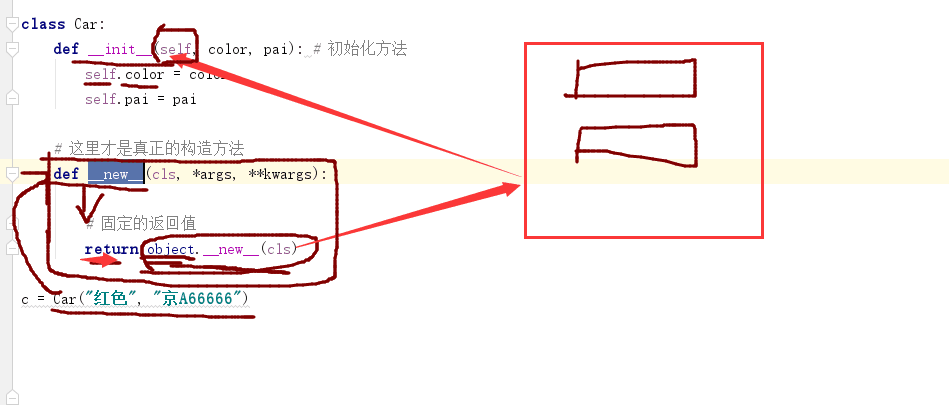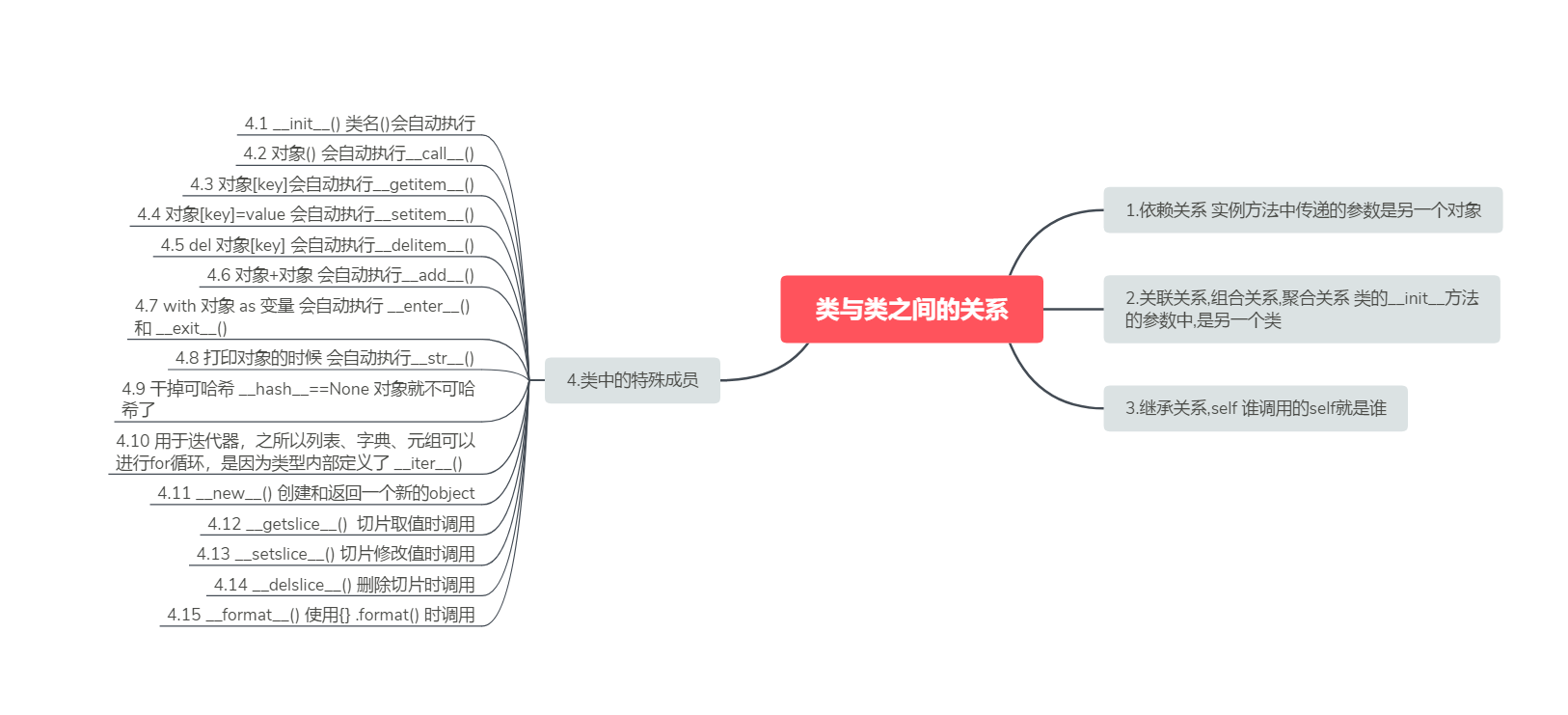
# class DaXiang: # def open(self, bx): # 这里是依赖关系. 想执行这个动作. 必须传递一个bx # print("大象高高兴兴走到了冰箱的面向前") # bx.kai() # 传递来的对象执行kai()动作 # print("大象成功的打开了冰箱门") # # def zhuang(self): # print("自己走进了冰箱") # # def close(self, bx): # print("大象要关冰箱门了") # bx.guan() # # # class BingXiang: # def kai(self): # print("我是冰箱. 我会开门 ") # def guan(self): # print("我是冰箱. 我会关门 ") # # class DianFanGuo: # def kai(self): # print("我是电饭锅 我能开 ") # def guan(self): # print("我是电饭锅, 我能关 ") # # # bx1 = BingXiang() # # bx2 = BingXiang() # dx = DaXiang() # dfg = DianFanGuo() # # dx.open(dfg) # dx.zhuang() # dx.close(dfg) # 植物大战僵尸. 创建一个植物. 创建一个僵尸 # 植物: 名字, 攻击力 # 僵尸: 名字, 血量 # 植物可以打僵尸. 僵尸掉血 # 显示出僵尸挨揍之后的血量 # class ZhiWu: # def __init__(self, name, attack, hp): # self.name = name # self.attack = attack # self.hp = hp # # def fight(self, js): # js.hp -= self.attack # # class JiangShi: # def __init__(self, name, hp, attack): # self.name = name # self.hp = hp # self.attack = attack # # def chi(self, zhiwu): # zhiwu.hp -= self.attack # # lvluo = ZhiWu("绿萝", 20, 10) # js1 = JiangShi("僵尸一号", 100, 5) # lvluo.fight(js1) # lvluo.fight(js1) # lvluo.fight(js1) # # js1.chi(lvluo) # js1.chi(lvluo) # js1.chi(lvluo) # print(lvluo.hp) # print(js1.hp)
# class Boy: # def __init__(self, name, girlFriend = None): # self.name = name # self.girlFriend = girlFriend # 关联关系 # # def chi(self): # b # if self.girlFriend: # self.girlFriend.happy() # print("%s和%s在吃饭" % (self.name, self.girlFriend.name)) # else: # print("没女朋友吃什么吃") # # class Girl: # def __init__(self, name): # self.name = name # # def happy(self): # print("有好吃的就开心") # # # b = Boy("王明") # g = Girl("肉丝") # # b对象的girlFriend赋值 g # # b.girlFriend = g # 突然天降女朋友 # b.chi() # b.girlFriend = None # b.chi() # # 老师和学生的关系. 一对多的关系 反过来就是一对一 # class Teacher: # def __init__(self, name, lst=None): # self.name = name # if lst == None: # 判断传递过来的参数是否是空 # self.lst = [] # else: # 传递过来的是一个列表 # self.lst = lst # # # 添加学生 # def tianjia(self, student): # self.lst.append(student) # # def display(self): # for s in self.lst: # s 是老师的学生 # print(s.name) # # # class Student: # def __init__(self, num, name, teacher=None): # self.name = name # self.num = num # self.teacher = teacher # # t = Teacher("大张伟") # s1 = Student(1, "郭德纲") # s2 = Student(2, "岳云鹏") # s3 = Student(3, "张鹤伦") # s4 = Student(4, "朱云峰") # # t.tianjia(s1) # 把学生添加给老师 # t.tianjia(s2) # t.tianjia(s4) # # t.display() # class Computer: # # def __init__(self, cpu, memory, yingpan, zhuban, xianshiqi): # pass # # # class Cpu: # pass # # class Memory: # pass # 帖子和评论 class Tie: def __init__(self, title, content, author, time, pinglun_lst = None): self.title = title self.content = content self.author = author self.time = time if pinglun_lst == None: self.pinglun_lst = [] else: self.pinglun_lst = pinglun_lst class Pinglun: def __init__(self, name, time, content, fav): self.name = name self.time = time self.content = content self.fav = fav pl1 = Pinglun("UZI", "昨天1", "UZI发出祝福",1888888) pl2 = Pinglun("xiaohu", "昨天2", "UZI发出祝福",1888888) pl3 = Pinglun("若风", "昨天3", "UZI发出祝福",1888888) pl4 = Pinglun("let me", "昨天3", "UZI发出祝福",1888888) pl5 = Pinglun("长长", "昨天4", "UZI发出祝福",1888888) pl6 = Pinglun("jackylove", "昨天5", "UZI发出祝福",1888888) pl7 = Pinglun("mlxg", "昨天6", "UZI发出祝福",1888888) pl8 = Pinglun("miss", "昨天7", "UZI发出祝福",1888888) lst = [] lst.append(pl1) lst.append(pl2) lst.append(pl3) lst.append(pl4) lst.append(pl5) lst.append(pl6) lst.append(pl7) lst.append(pl8) # 显示帖子的内容. 评论的内容 tie = Tie("S8_IG夺冠. 王思聪怒吃热狗. ", "IG的上单The Shy疯了一样. 一个打5个. 自己人都不放过", "王明","某年某月某一天",lst ) print(tie.content) # 评论 # print(tie.pinglun_lst) for pl in tie.pinglun_lst: print(pl.content)
# class Foo: # def __init__(self): # pass # def method(self): # pass # # 该类的对象就不可哈希了 # __hash__ = None # # # # print(hash(Foo)) # 类和对象默认都是可哈希的 # print(hash(Foo())) # unhashable type: 'Foo' # 做作业的时候能用到 # dic = {Foo: Foo(), Foo():'胡辣汤'} # s = [] # print(hash(s)) # 列表是不可哈希的 class Base: def __init__(self, num): self.num = num def func1(self): print(self.num) self.func2() def func2(self): print(111, self.num) class Foo(Base): def func2(self): print(222, self.num) lst = [Base(1), Base(2), Foo(3)] for obj in lst: obj.func2() # self: 谁调用的就是谁 # class Car: # def run(self): # print("我的车会跑") # # # CarCarCar = Car # 类名是变量 # # c = CarCarCar() # c.run() # # # def func(): # print("我是函数") # func() # # fn = func # fn() def func(): print("娃哈哈 ") func()
# class Car: # def __init__(self, color, pai): # self.color = color # self.pai = pai # def __call__(self, *args, **kwargs): # print("这里是call") # # def __getitem__(self, item): # print("这里是getitem, item=", item) # # def __setitem__(self, key, value): # print(key, value) # # def __delitem__(self, key): # print(key) # # def __add__(self, other): # 在执行两个对象相加的时候自动调用 # print("证明我来过") # def __enter__(self): # print("进来的时候") # def __exit__(self, exc_type, exc_val, exc_tb): # print("这里是出去") # # def __str__(self): # 当前对象的字符串表示形式 # return "我的车很厉害" # # def __repr__(self): # 一个对象的官方字符串表示形式 # return "我的车非常非常厉害" # # def __iter__(self): # return (i for i in range(10)) # # # def __hash__(self): # # return hash(self.pai) + hash(self.color) # __hash__ = None # # # c = Car("红", "1.5T") # 在创建对象的时候会自动的调用__init__() 类名() ==> init() # # c() # 对象() => __call__() # # c["马化腾"] # 对象[任意参数] => __getitem__(item) # # c["胡辣汤"] = "河南开封" # # del c['上海小混沌大碗'] # # # c2 = Car("黑色", "1.8T") # # cc = c+c2 # # # with c as m: # 装饰器 # # print("哈哈哈") # # # # print("呵呵呵") # # print(c) # 当打印一个对象的时候. 默认的去执行__str__ 根据__str__返回的结果进行打印 # # print(repr(c)) # # print("%s" % c) # %s __str__ # print("%r" % c) # %r __repr__ # # # c > c2 # great than # # c< c2 # less than # # c >= c2 # greate and equals # # for s in c: # print(s) class Car: def __init__(self, color, pai): # 初始化方法 print("哪有地呀") self.color = color self.pai = pai # 这里才是真正的构造方法 def __new__(cls, *args, **kwargs): print("我的天哪") # 固定的返回值 return object.__new__(cls) c = Car("红色", "京A66666") # 先执行__new__ 返回object.__new__(cls).把返回的空对象传递给 __init__() print(c.color)
__call__
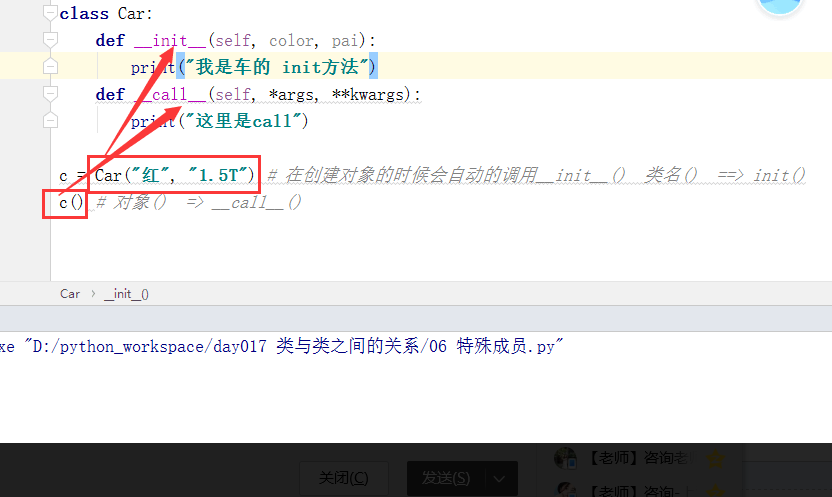
__getitem__

__setitem__
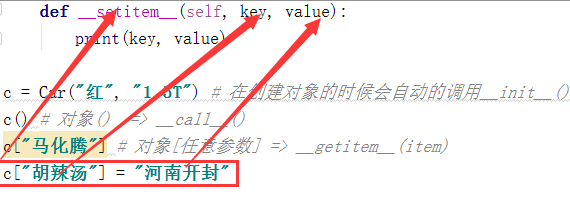
__add__
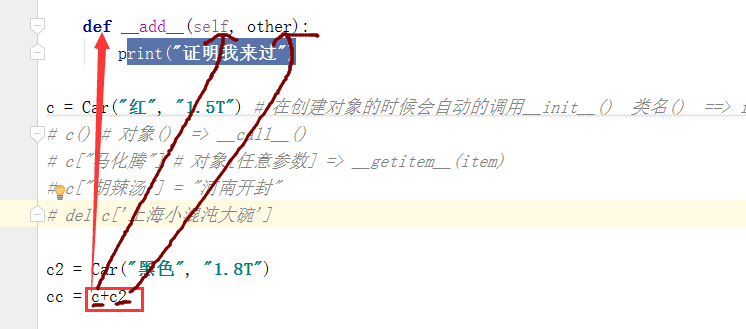
__enter__ 和 __exit__

__new__
